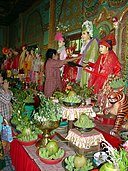Shwe Hpyin Naungdaw
Shwe Hpyin Naungdaw (ရွှေဖျင်းနောင်တော် [ʃwèbjɪ́ɰ̃ nàʊɰ̃dɔ̀]; lit. 'Goldpot the Elder'), also called Shwe Hpyin Gyi (ရွှေဖျင်းကြီး [ʃwèbjɪ́ɰ̃ dʑí]) or Min Gyi (မင်းကြီး [mɪ́ɰ̃ dʑí]), is one of the 37 nats in the official pantheon of Burmese nats. He is the elder brother of Shwe Hpyin Nyidaw and the son of Popa Medaw, another nat. Worshippers of this nat avoid consumption of pork, as Shwe Hpyin Gyi's father, Byatta, is believed to have been an Indian Muslim.[1]
They were killed for neglecting their duty to provide a brick each thus leaving gaps in Taungbyone Pagoda, which was built by King Anawrahta.[2] After death, the brothers became spirits and manifested themselves in front of King Anawrahta, requesting apaing-za (possession) of territory. Responding to their plea, King Anawrahta granted them possession of Taungbyon.[3]
They are portrayed on pedestals, one lying down and the other upright with his sword shouldered arrogantly.[4] Worshippers of this nat avoid consumption of pork, as Shwe Hpyin Gyi's father, Byatta, is believed to have been an Indian Muslim.[5]
The largest Nat festival in Myanmar is the Taungbyone Festival, celebrated annually for six days in Taungbyone village near Mandalay. The festival pays tribute to the Shwe Hpyin brothers. Thousands of festive worshippers gather for the event, engaging in dance with spirit mediums, enjoying roadside snacks, and shopping for souvenirs.[6]
References
- ^ Gilbert, David (15 August 2013). "Myanmar's Multicultural Spirits". The Irrawaddy. Retrieved 8 September 2013.
- ^ Shwe Mann Maung. "The Taung Byone Nat Festival". Perspective (August 1997). Archived from the original on 2004-07-17. Retrieved 2008-09-11.
- ^ "အုတ်နှစ်ချပ်လပ်ရာမှ အစပြု၍". Eleven Media Group Co., Ltd (in Burmese).
- ^ Hla Thamein. "Thirty-Seven Nats". Yangonow. Archived from the original on 2006-06-24. Retrieved 2006-07-03.
- ^ Gilbert, David (15 August 2013). "Myanmar's Multicultural Spirits". The Irrawaddy. Retrieved 8 September 2013.
- ^ "Speaking with the spirits". Nation Thailand. 23 August 2013.


